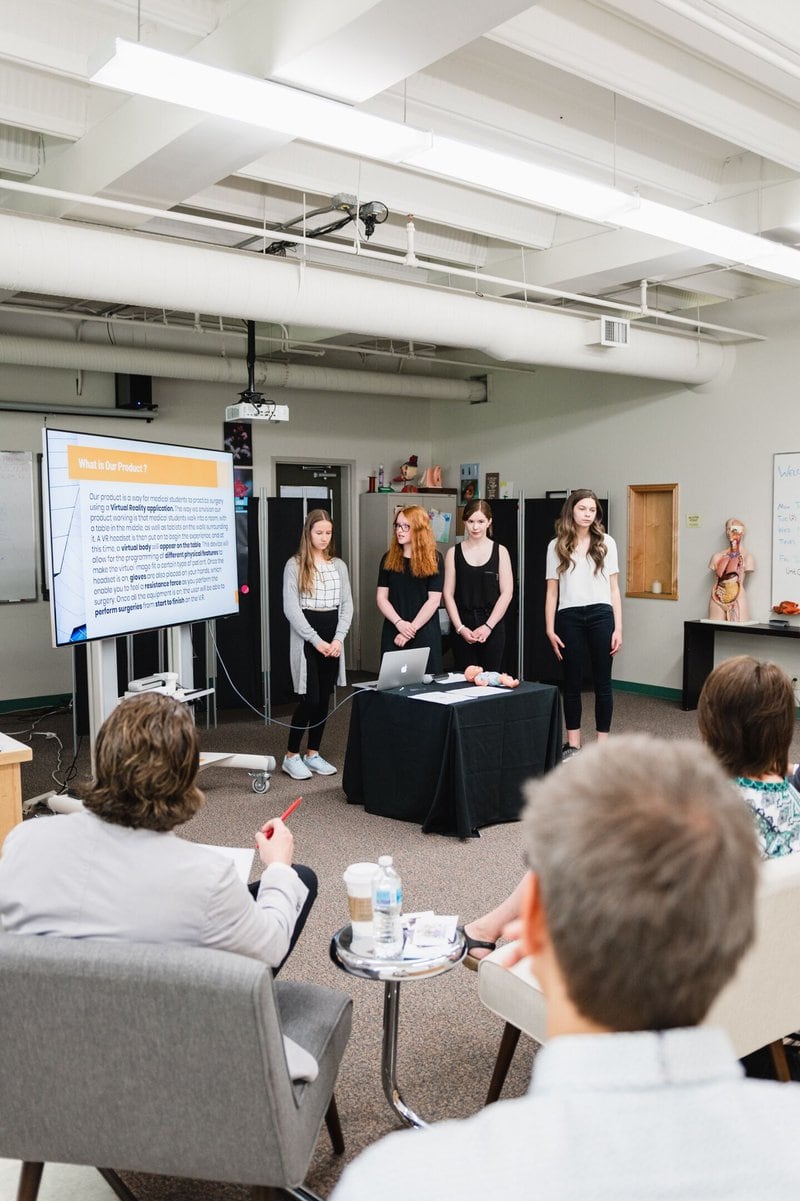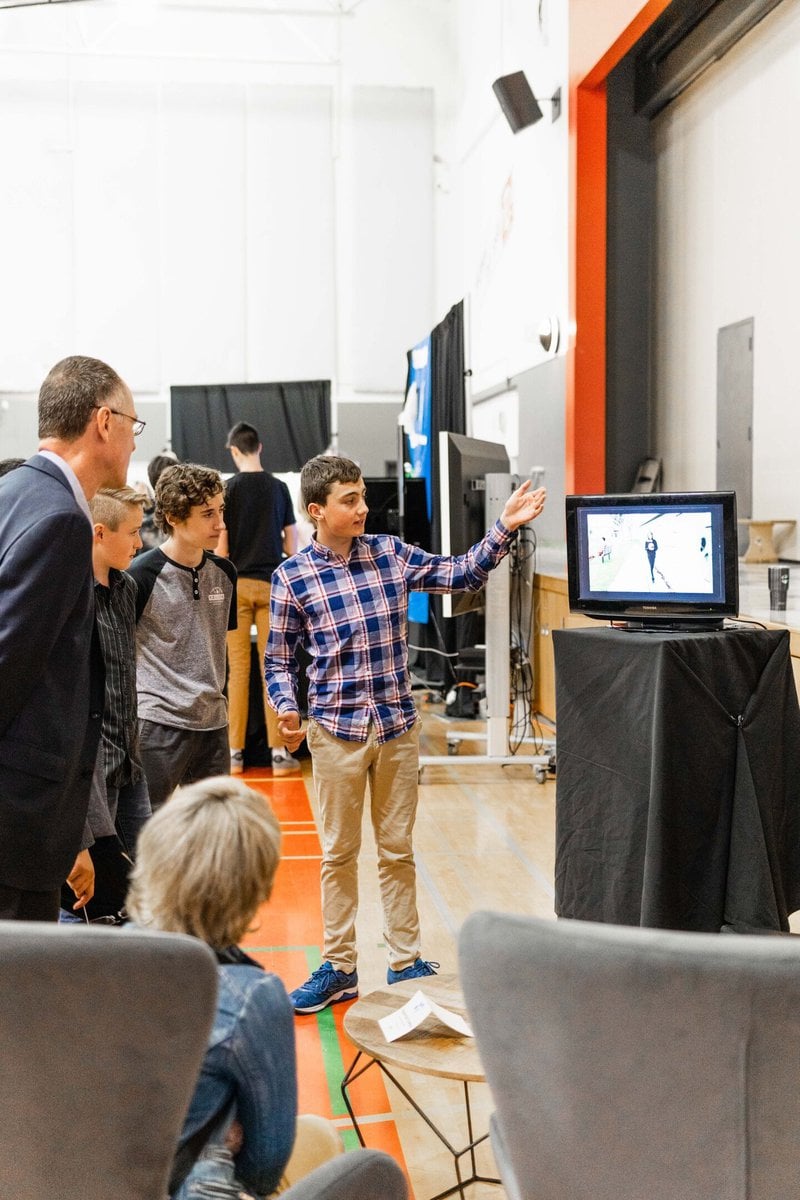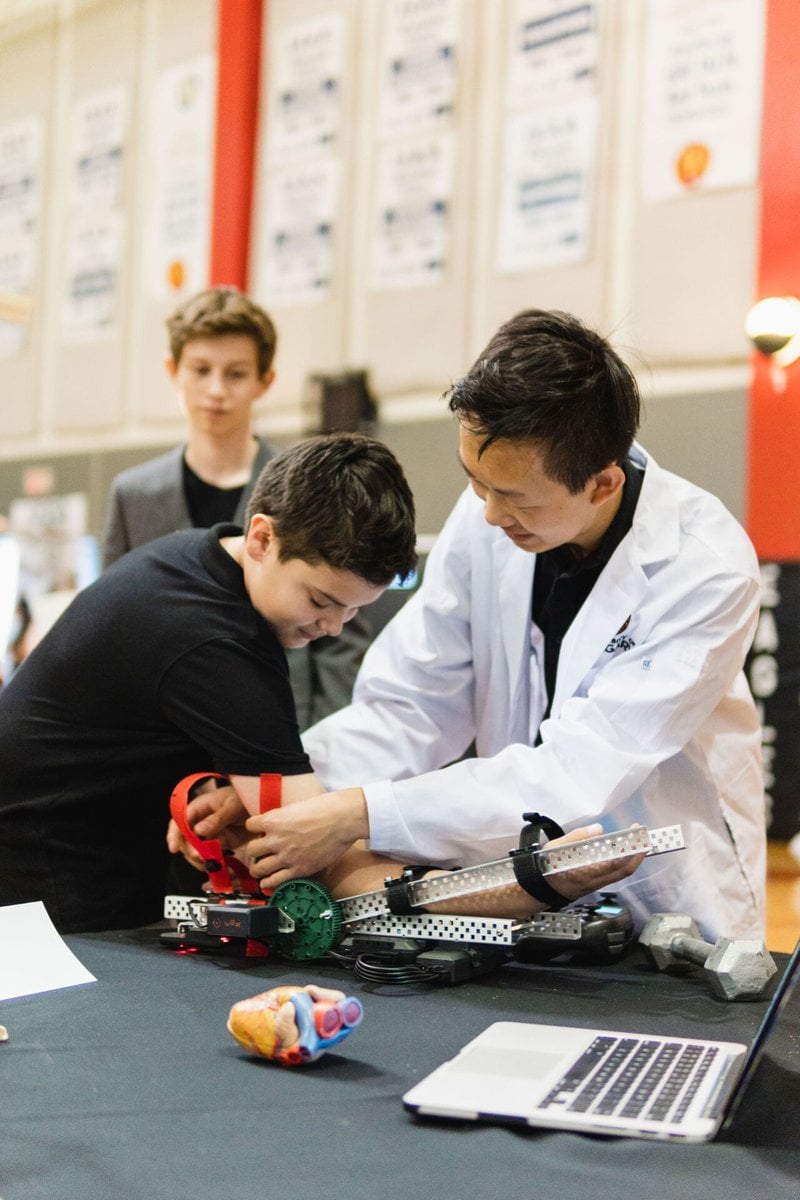An IMAGINAL BOLD Challenge.
Ending the school year in a shark tank! Surely not!
Fortunately, “the shark tank” is a metaphor! The students at Master’s are safe, but they have been taking calculated risks in their learning.
Risk-Taking in the Ocean Playgrounds
 Out there in the big ocean playgrounds, there is a shark tank that invites a certain caliber of risk taker. Sending a diver to observe dangerous types of sharks while encased in a metal cage can only be tagged as ‘relatively safe’! It has been said by those crazy enough to try it, that swimming with the sharks involves an adventure where you don a wet suit and enter a wire cage with significant open spaces between the bars and agree to be dangled into shark-infested waters. It requires patience in freezing cold water with a strong current where almost all attention and energy goes to keeping one’s mouth above the water to breathe and holding on to the bars of the cage to keep all limbs safely inside.
Out there in the big ocean playgrounds, there is a shark tank that invites a certain caliber of risk taker. Sending a diver to observe dangerous types of sharks while encased in a metal cage can only be tagged as ‘relatively safe’! It has been said by those crazy enough to try it, that swimming with the sharks involves an adventure where you don a wet suit and enter a wire cage with significant open spaces between the bars and agree to be dangled into shark-infested waters. It requires patience in freezing cold water with a strong current where almost all attention and energy goes to keeping one’s mouth above the water to breathe and holding on to the bars of the cage to keep all limbs safely inside.
Who does that, you might ask? Who will risk life and limb for such an experience?
Risk-Taking in Business
For those who watch the TV show “Shark Tank” you will be aware that it involves taking your small business idea to the big show, hopefully landing a shark (investor), and going on to build a company that provides a comfortable income. Those fortunate enough to land an investor or two say that taking a chance with the “sharks” is worth it.
 Risk-Taking at Master’s Academy & College
Risk-Taking at Master’s Academy & College
At Master’s, we ended the year with a simulated shark tank experience where adrenaline was flowing, risks were being taken, the outcome seemed uncertain and our futures hung in the balance. Grade 7-12 Students at Master’s Academy and College recently engaged in a home-grown Imaginal Design course where their innovative ideas were presented in the form of a BOLD IMAGINAL challenge at the end of the school year. The course is designed to push students into thinking of the opportunities that will likely be theirs after their school days are over. It is a course in innovative thinking and design as an expression of being Future Ready. The course is in stark contrast to the rest of the mandated curriculum that deals only with past knowledge. Traditionally, students’ educational experiences are involved with past, already known knowledge. This Imaginal course is all about the future; the unknown, the uncertain. The focus is on developing the four Imaginal Capacities to Improve, Innovate, Invent and Integrate. It  forces the development of the necessary transferable skills of risk taking and problem solving along with critical and creative thinking. Nothing seems predictable or prescribed in this course, but there are specific tools and processes that allow students to “see” into the future studying s-curve trends and doing future wheel impact analysis. Students at Master’s are being exposed to thought processes usually reserved for post secondary and graduate programs. They have, however, risen to the challenge!
forces the development of the necessary transferable skills of risk taking and problem solving along with critical and creative thinking. Nothing seems predictable or prescribed in this course, but there are specific tools and processes that allow students to “see” into the future studying s-curve trends and doing future wheel impact analysis. Students at Master’s are being exposed to thought processes usually reserved for post secondary and graduate programs. They have, however, risen to the challenge!
Risk-Taking Students
In the words of the Grade 8 students, who all faced the sharks (judges who are real entrepreneurs and investors), “Trying to get ideas and formulate a plan is slow and hard. You have to push through random and blotchy conversations until the momentum carries you. You’re often immersed in uncertainty and we didn’t always end with what we started. It’s not easy to get the main idea on the table when you are unsure yourself and your team has differing ideas.” These students speak of the need to persevere and to be willing to start again and to iterate over and over. They refer to the level of maturity necessary to take risks and manage their stress. In their words, “We felt a lot older dealing with the complexity that gave us a sense of greater responsibility and purpose.” As the students reflected on the Imaginal Design course, they expressed that they “…felt freedom and openness coming out. Our minds opened a gate to what we wanted to do. This course prepares us for the future by giving us the chance to create our own businesses from the perspective of personal interest and our desire to help people. We had to prepare studies and surveys to learn what customers want and need and we began to sense what we were capable of and how to contribute to society.

Geneva’s team innovated a calligraphy pen design that sends out a laser beam to guide the scribe, while Rylee’s team invented virtual reality eye glasses that assist disabled people to read with fluency and accuracy. Adria’s team created a “smart” sweater, while Ronan’s group developed a veterinary data-base for global cross referencing. Jessie and her team, with an eye to their future in medicine, developed an idea around a surgical dummy that would replace the need for cadavers. All these students faced the shark tank as they presented their business plans and dreams to a panel of investors.
Speaking about other presentations in different grades, students made the connection to the real world by saying, “this is what people do in the world outside school.” These BOLD challenges that focused on creation were as diverse as the passions of their creators. It was obvious to see talents and interests emerge in floating cars of the future, unique fashion designs, and solutions to mental health along with bio-med and bio-tech projects that pushed students to look into the future of space, sports and medicine.
We heard from the students that their innovative process was an “emotional roller-coaster ride” and they learned that “stress is a major companion of design” especially when you are creating prototypes that require adaptation and improvisation. Asked how they felt on presentation day – “proud” was the overwhelming response! Master’s students are indeed demonstrating the transferable skills to take risks and be courageous in engaging with their futures.


Risk-Taking and Courage
Bernard Bull, former Chief Innovation Officer at Concordia University and currently President of Goddard College in Vermont, confirms what’s needed in the “shark tank”. “As I see it, courage and risk-taking are close relatives, and both are required to embrace and act upon a life of self-directed learning… It is courage that allows one to take the next step as a learner. It takes courage to be transparent about our limited knowledge and skill, to build new learning connections with others, to fuel our learning goals with action. As such, courage and calculated risk-taking is among the more fundamental skills of the self-directed learner.” (Risk Taking as a 21st Century Skill – April 25, 2014)
Risk-Taking as a Teacher
Instructional consultant Monique Bowes says, “I hope that when my own two little boys are in school that they will be fortunate enough to be taught by teachers who are risk takers. I firmly believe that as professionals, it is essential that we take risks in our pedagogical approach and practice… it takes a whole lot of risks and failure to get to awesome”. (Risk-Taking = Great Teaching? March 10, 2013 in Ed Tech)
Well, the awesome teachers who lead the Imaginal Design courses have lived up to their reputation as stated by their students. “The teachers are our inspiration and encouragers. They keep telling us to think of a way around the problem and that they are alongside us because they don’t know all the answers either. We know that the teachers have made this course different and we don’t stress out like we do on unit tests. We are supported in thinking of where the experience will lead us.” (Student perspectives) So, yes, these teachers have taken risks by placing themselves in less predictable teaching situations as they provided future thinking projects for their students, but their JOY comes from hearing their students speak of where this learning has taken everyone on the journey – teachers included!
“If we create a culture where every teacher believes they need to improve, not because they are not good enough but because they can be even better, there is no limit to what we can achieve.” – Dylan Wiliam (British Educationalist and leader in assessment)
An Unknown Better
George Couros, author of “The Innovator’s Mindset” defines risk as “moving from a comfortable ‘average’ in pursuit of an unknown better”. The adults who attended the IMAGINAL BOLD challenge as guests or judges, caught the spirit of the “shark tank”.
“Thank you for allowing me to participate as a judge in what I would characterize as an “above and beyond” educational experience for our children. You (the teacher) and the rest of the Master’s staff have done an outstanding job of not just inspiring children to be creative, but to solve real world problems and present them with a sound business case.” – Sean Hennessy

Ending the year in a “shark tank” is a powerfully messy business
With summer just around the corner, we draw towards the end of a year where we began a pilot curriculum around Innovation and Design. Imaginal thinking is now a bedrock term in this curriculum and we raise a cheer for the staff and students who engaged brilliantly in the process.
“Learning is a messy process, which is what makes it so powerful…. I believe we need to inspire our kids to follow their passions, while letting them inspire us to do the same.” – George Couros
